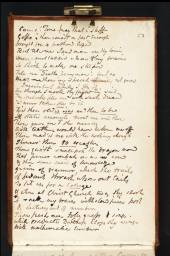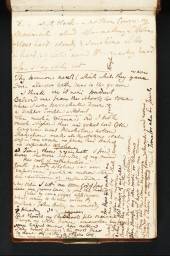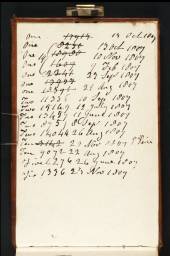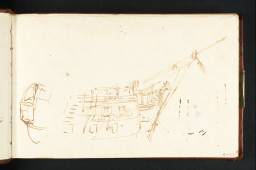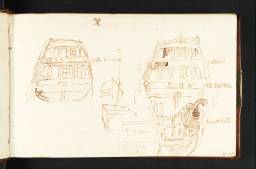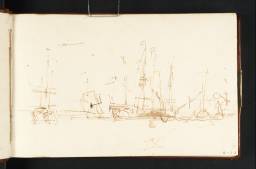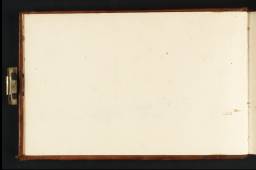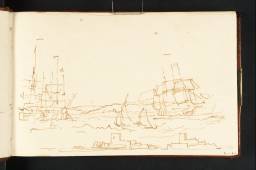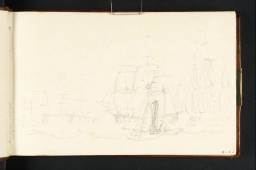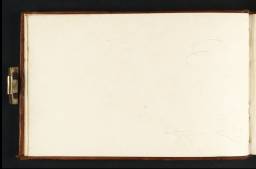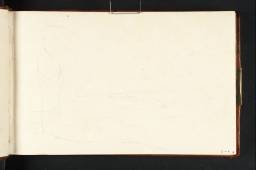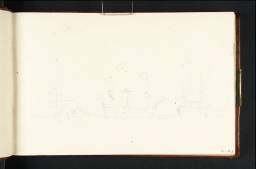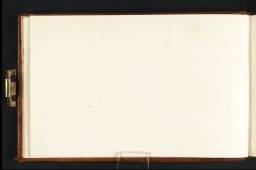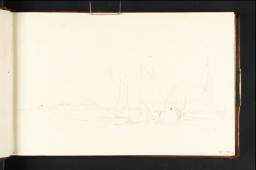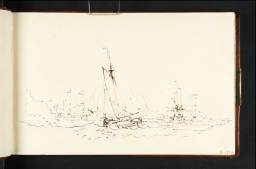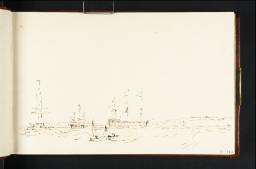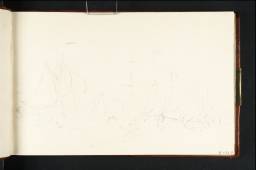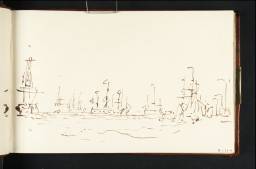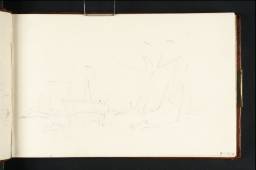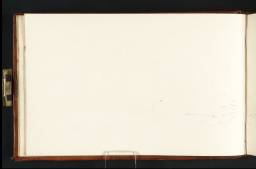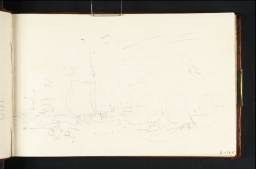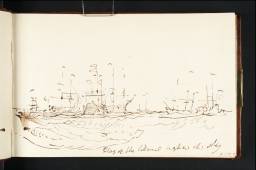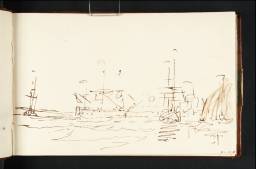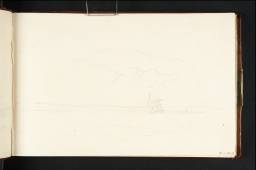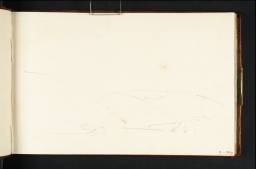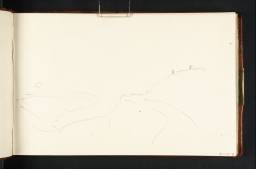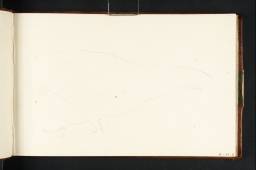J.M.W. Turner
>
1802-18 Academician and professor
>
Marine subjects c.1803-14
>
Spithead Sketchbook
Turner Bequest C
Sketchbook, bound in calf, with one brass clasp
80 leaves of off-white wove Whatman paper, made on a double-faced mould
Approximate page size 118 x 187 mm
Made by William Balston and Finch and Thomas Robert Hollingworth at Turkey Mill, Kent, and watermarked ‘J WHATMAN | 1805’
Inscribed by Turner in ink ‘Shipping’ on a label on the spine (D40732) and ‘River Thames | Margate’ on the back cover (D40615)
Numbered in ink ‘329’ as part of the Turner Schedule, and endorsed by the Executors of the Turner Bequest; inscribed by Charles Turner in ink ‘No 329 Contains | 64 leaves in Pencil | & Pen & Ink | C Turner’, and in pencil by John Prescott Knight ‘J.P.K’ and Charles Lock Eastlake ‘C.L.E.’ inside back cover
80 leaves of off-white wove Whatman paper, made on a double-faced mould
Approximate page size 118 x 187 mm
Made by William Balston and Finch and Thomas Robert Hollingworth at Turkey Mill, Kent, and watermarked ‘J WHATMAN | 1805’
Inscribed by Turner in ink ‘Shipping’ on a label on the spine (D40732) and ‘River Thames | Margate’ on the back cover (D40615)
Numbered in ink ‘329’ as part of the Turner Schedule, and endorsed by the Executors of the Turner Bequest; inscribed by Charles Turner in ink ‘No 329 Contains | 64 leaves in Pencil | & Pen & Ink | C Turner’, and in pencil by John Prescott Knight ‘J.P.K’ and Charles Lock Eastlake ‘C.L.E.’ inside back cover
Accepted by the nation as part of the Turner Bequest 1856
Exhibition history
1869
Third Loan Collection, various venues, 1869–1931 (123a–d).
1990
Painting and Poetry: Turner’s ‘Verse Book’ and his Work of 1804–1812, Tate Gallery, London, June–September 1990 (31).
2003
The Sun rising through Vapour: Turner’s Early Seascapes, Barber Institute of Fine Arts, University of Birmingham, October 2003–January 2004 (13).
2005
Turner: The Sea, Clore Gallery, Tate Britain, London, March–October 2005, Tate Liverpool, November 2005–May 2006.
References
1909
A.J. Finberg, A Complete Inventory of the Drawings of the Turner Bequest, London 1909, vol.I, pp.260–3, C.
1910
A.J. Finberg, Turner’s Sketches and Drawings, London 1910, pp.60–1.
1974
Gerald Wilkinson, The Sketches of Turner, R.A. 1802–20: Genius of the Romantic, London 1974, pp.88–9.
1980
Andrew Wilton, Turner and the Sublime, exhibition catalogue, Art Gallery of Ontario, Toronto 1980, p.110.
1984
Martin Butlin and Evelyn Joll, The Paintings of J.M.W. Turner, revised ed., New Haven and London 1984, pp.60, 69.
1987
Andrew Wilton, Turner in his Time, London 1987, p.87.
1989
Martin Butlin, Mollie Luther and Ian Warrell, Turner at Petworth: Painter and Patron, London 1989, p.121 note 33.
1990
Andrew Wilton and Rosalind Mallord Turner, Painting and Poetry: Turner’s ‘Verse Book’ and his Work of 1804–1812, exhibition catalogue, Tate Gallery, London 1990, pp.19, 41, 42, 127.
1996
Gillian Forrester, Turner’s ‘Drawing Book’: The Liber Studiorum, exhibition catalogue, Tate Gallery, London 1996, pp.24 note 77, 74 note 3, 97.
1996
Jan Piggott, ‘A Lyric in Turner’s Spithead Sketchbook identified’, Turner Society News, no.74, December 1996, pp.12–13.
2002
David Blayney Brown, Turner in the Tate Collection, London 2002, p.76.
2003
Paul Spencer-Longhurst, The Sun rising through Vapour: Turner’s Early Seascapes, exhibition catalogue, Barber Institute of Fine Arts, University of Birmingham 2003, pp.38, 48.
This sketchbook was mainly used for marine and rustic subjects. In 1807 Turner took it with him to Portsmouth and Spithead to draw shipping including prizes from the Danish navy captured by the British at Copenhagen. He used his sketches as references for Spithead: Boat’s Crew Recovering an Anchor (Tate N00481), first shown in Turner’s Gallery, 1808.1 There is also a study for The Sun Rising through Vapour (Barber Institue of Fine Arts, University of Birmingham), the second of Turner’s two pictures of this title painted circa 1809.2 The rural scenes and sketches of rustic or domestic life must have been made on the way to or from the coast as they depict places on the Portsmouth road. Several are connected with subjects in Turner’s Liber Studiorum. There are also passages of poetry.
As noted above, Turner’s own label on the spine stated only ‘Shipping’, while further inscriptions on the cover located the settings as ‘River Thames’ and ‘Margate’, although the last word was crossed out. There are no certain Thames subjects in the book, although some lines of verse do mention the river (see below) and the sunset view on folio 45 verso (D06565; Turner Bequest C 41a) could possibly be near Twickenham while the drawing on folio 75 (D06606; Turner Bequest C 70) used for The Sun Rising through Vapour could have been made near the mouth of the Estuary, from the north bank looking east. However, it could just as well be another scene on Portsmouth harbour. The picture was bought by Walter Fawkes and hung in his drawing room at Farnley Hall, Yorkshire on the same wall (and thus effectively as the pair to) The Victory Returning from Trafalgar (Yale Center for British Art, New Haven, Connecticut), which Turner set off the Isle of Wight, near the Needles.3 The series of Portsmouth subjects in the book, associated with the 1808 Spithead, accounted for Finberg’s renaming of it as Spithead, the title still used today. Having watched the Victory arrive at Sheerness with the body of Nelson after the Battle of Trafalgar in 1805, studied the ship in Chatham dockyard and subsequently painted the Battle, Turner was now applying himself to what must at first have seemed another patriotic marine subject, the arrival of the Danish prizes.
As noted above, Turner’s own label on the spine stated only ‘Shipping’, while further inscriptions on the cover located the settings as ‘River Thames’ and ‘Margate’, although the last word was crossed out. There are no certain Thames subjects in the book, although some lines of verse do mention the river (see below) and the sunset view on folio 45 verso (D06565; Turner Bequest C 41a) could possibly be near Twickenham while the drawing on folio 75 (D06606; Turner Bequest C 70) used for The Sun Rising through Vapour could have been made near the mouth of the Estuary, from the north bank looking east. However, it could just as well be another scene on Portsmouth harbour. The picture was bought by Walter Fawkes and hung in his drawing room at Farnley Hall, Yorkshire on the same wall (and thus effectively as the pair to) The Victory Returning from Trafalgar (Yale Center for British Art, New Haven, Connecticut), which Turner set off the Isle of Wight, near the Needles.3 The series of Portsmouth subjects in the book, associated with the 1808 Spithead, accounted for Finberg’s renaming of it as Spithead, the title still used today. Having watched the Victory arrive at Sheerness with the body of Nelson after the Battle of Trafalgar in 1805, studied the ship in Chatham dockyard and subsequently painted the Battle, Turner was now applying himself to what must at first have seemed another patriotic marine subject, the arrival of the Danish prizes.
During 1807, following the Treaty of Tilsit between France, Russia and Prussia and Napoleon’s establishment in 1806 of a Continental System denying British shipping access to ports, the Tsar undertook to bring the neutral Scandinavian countries into the new alliance. To prevent the Danish navy falling into enemy hands, the British sent an expeditionary force and a request that the fleet, lying in the harbour at Nyholm, Copenhagen, surrender and place itself under British protection; if this were not done, the British threatened to seize it and to bombard the city. When the Danes refused to comply, the British forced the surrender of the Danish fleet on 7 September. On 14 October the first of the prizes set sail for England under Vice-Admiral Stanhope. Dispersed by bad weather, they arrived on different days, 30 October and 1 November.
According to Butlin and Joll, Turner’s picture depicts two ships that arrived on the later day, the Trekroner (Three Crowns) and the Danmark (Denmark). A note on folio1 (D41429) probably describes the ‘cloudy sunshine’ and ‘hard squaly wind’ as the ships passed St Helen’s on the eastern edge of the Isle of Wight, and the settings of their sails. Details of the Trekroner are drawn on folio 3 (D06519). However, if all the other drawings of shipping in the sketchbook are true portraits and made on the same occasion, Turner must have worked very quickly as he was back in London for a general meeting of the Royal Academy on 2 November. In fact, the number of sketches and their various viewpoints, sometimes apparently taken from a boat, from distant harbour views to close-up studies of vessels, and depicting weather conditions ranging from rough to calm, would indicate much more than a day’s work, some of it probably after the ships arrived and reached their anchorage. The sketches also differ in medium and handling, suggesting production over an extended period. They vary from pencil sketches with various degrees of shading, but usually spontaneous in feeling, to studies in ink, sometimes drawn with a broad-nibbed pen and sometimes with a finer one.
In Turner’s Gallery in 1808, the resulting picture was described (probably by John Landseer) in the Review of Publications of Art as ‘two of the DANISH SHIPS which were seized at COPENHAGEN, entering Portsmouth Harbour’. But by 1809, when it reappeared at the Royal Academy, it had been rechristened with its current title, eliminating all reference to the historical circumstances or the origin and nationality of the ships. As Butlin and Joll explain, this must have been because of the political outcry that blew up after the event. The British action was controversial as the accuracy of the original intelligence was hard to prove and the Danes were not hostile. Its almost immediate results were that Denmark and Norway joined the Continental System and Russia broke off relations with Britain, assuming attitudes of injured innocence. The Danish prizes soon became an embarrassment. Moreover they were only of limited use to the British navy, which lacked the manpower – both in dockyard workers and crews – to refit more than a few for operational service. Of fifteen Danish battleships taken, only four were put to active use, one being the Danmark.
Besides shipping subjects, the sketchbook contains various quick pencil sketches of scenery around Guildford, Hindhead and Liphook. Finberg, and later Gillian Forrester in her study of the Liber Studiorum, state categorically that they were made on the way back from Portsmouth, but while some, the merest outlines, could have been made from a moving coach, Turner would hardly have had the time to do all this drawing if he really was at Portsmouth on 1 November and at the Academy meeting in London the next day. As well as landscapes, there are scenes of rural life and agriculture including ploughing, similar to others in the roughly contemporary Windsor and Eton sketchbook (Tate D06072–D06179; D40655–D40658; Turner Bequest XCVII). Interiors of cottages or barns reflect Turner’s current interest in rustic narrative under the stimulus of recent pictures by David Wilkie.
Turner’s concern with other works of art is evident from further leaves of the book. At the opposite extreme to the familiar English scenes is a carefully drawn study on folio 48 (D06586) of a historic landscape composition with figures, perhaps Tobias or Hagar and the Angel and based on some Old Master picture. Folio 63 verso (D06593; Turner Bequest C 58a) has comments on various pictures and artists including Giulio Romano; in connection with a picture or perhaps a sculpture of the game of knucklebones, Turner appears to contrast ‘exalted imagination, sublime inspiration’ with ‘simple nature’ where the naturalism and expression – ‘physionomy [sic], &c’ – are paramount. Turner had for the last year been thinking about varieties of subject matter in connection with the Liber Studiorum, his collection of illustrations of types of landscape, and the origins of Liber designs can be traced to four drawings in the book: of men hedging and ditching on folio 52 (D06571; Turner Bequest C 47), Hindhead on folio 54 verso (D06576; Turner Bequest C 49a), a water mill on folio 57 verso (D06582; Turner Bequest C 52a) and St Catherine’s Hill on folio 78 verso (D06613; Turner Bequest C 73a). The various verses written in the book include lines inside the back cover (D40614) on ‘Hind head, tho[u] cloud-capt winded hill’. These approach a Romantic intensity of feeling. On folio 76 (D06608; Turner Bequest C 71), on the other hand, are verses on Thames scenery in a more traditional Augustan metre and citing Alexander Pope. Both passages seem to be Turner’s work. The long, comic-wistful poem on the passage of time inside the front cover and on folio1 (D41428, D41429) is copied from a recent poem by the dramatist George Colman the younger.
On folio 1 verso (D41430) and inside the back cover (D40614) columns of figures, dates during 1807 and, apparently, sums of money are recorded. These must represent bank drafts or, as Finberg suggested, Navy Notes, and are related to Turner’s finances rather than, as Spencer-Longhurst says, to his ‘use of the book as an aide-mémoire extending to listing the dates on which it was used’.4
Technical notes
Peter Bower5 has noted the paper used in this book, a Whatman paper made by William Balston and the Hollingworth brothers at Turkey Mill, Maidstone, Kent. Finberg dated it, on the basis of watermarks, ‘probably 1803’ but Bower prefers 1805 and compares it with the 1805 watermark in the Boats, Ice sketchbook (Tate D06618–D06715; D40801–D40803; Turner Bequest CI), suggesting that the two books were made up by the same (unidentified) binder from the same batch of paper.
The book displays typical evidence of interventions by John Ruskin. He started numbering the folios, in his usual red ink, but when he reached 15 he must have realised that Turner had made most of his drawings with the book the other way up and started again in the opposite direction. This second sequence, applied to the whole book, formed the basis for Finberg’s numbering. It does not reflect the current order, however. As Finberg noted, several leaves were cut out of the book. These may have included four leaves chosen by Ralph Wornum for inclusion in the Third Loan Collection touring display, which Finberg listed as pages 89–93 in the Boats, Ice book and described as ‘possibly belonging to it’. Pencil notes by Edward Croft-Murray in a copy of Finberg (Tate library) dismiss Finberg’s speculation about these leaves (‘Certainly not, they are not the same size’) and record their subsequent incorporation here, where they are now placed as folios 40, 42, 44 and 51; D06719, D06716, D06717 and D06718).
A concordance of Tate and Finberg numbers follows.
| Folio | Tate | Turner Bequest |
| Label on Spine | D40732 | – |
| Inside Front Cover | D41428 | – |
| 1 Recto | D41429 | ‘flyleaf’ |
| 1 Verso | D41430 | ‘flyleaf’ |
| 2 Recto | D06518 | C 1 |
| 3 Recto | D06519 | C 2 |
| 4 Recto | D06520 | C 3 |
| 4 Verso | D40605 | – |
| 5 Recto | D06521 | C 4 |
| 6 Recto | D06522 | C 5 |
| 7 Recto | D06523 | C 6 |
| 8 Recto | D06524 | C 7 |
| 8 Verso | D06525 | – |
| 9 Recto | D06526 | C 8 |
| 10 Recto | D06527 | C 9 |
| 10 Verso | D40606 | – |
| 11 Recto | D06528 | C 10 |
| 12 Recto | D06529 | C 11 |
| 13 Recto | D06530 | C 12 |
| 14 Recto | D06531 | C 13 |
| 15 Recto | D06532 | C 14 |
| 16 Recto | D06533 | C 15 |
| 16 Verso | D06534 | – |
| 17 Recto | D06535 | C 16 |
| 18 Recto | D06536 | C 17 |
| 19 Recto | D06537 | C 18 |
| 20 Recto | D06538 | C 19 |
| 21 Recto | D06539 | C 20 |
| 22 Recto | D06540 | C 21 |
| 23 Recto | D06541 | C 22 |
| 24 Recto | D06542 | C 23 |
| 25 Recto | D06543 | C 24 |
| 25 Verso | D40607 | – |
| 26 Recto | D06544 | C 25 |
| 26 Verso | D40608 | – |
| 27 Recto | D06545 | C 26 |
| 27 Verso | D40609 | – |
| 28 Recto | D06546 | C 27 |
| 28 Verso | D40610 | – |
| 29 Recto | D06547 | C 28 |
| 29 Verso | D40611 | – |
| 30 Recto | D06548 | C 29 |
| 30 Verso | D40612 | – |
| 31 Recto | D06549 | C 30 |
| 32 Recto | D06550 | C 31 |
| 32 Verso | D06551 | C 31 a |
| 33 Recto | D06552 | C 32 |
| 34 Recto | D06553 | C 33 |
| 35 Recto | D06554 | C 34 |
| 36 Recto | D06555 | C 35 |
| 36 Verso | D06556 | C 35 a |
| 37 Recto | D06557 | C 36 |
| 37 Verso | D06558 | C 36 a |
| 38 Recto | D06559 | C 37 |
| 38 Verso | D06560 | C 37 a |
| 39 Recto | D06561 | C 38 |
| 40 Recto | D06719 | CI 92 |
| 41 Recto | D06562 | C 39 |
| 42 Recto | D06716 | CI 89 |
| 43 Recto | D06563 | C 40 |
| 44 Recto | D06717 | CI 90 |
| 44 Verso | D40613 | – |
| 45 Recto | D06564 | C 41 |
| 45 Verso | D06565 | C 41 a |
| 46 Recto | D06566 | C 42 |
| 47 Recto | D06567 | C 43 |
| 48 Recto | D06568 | C 44 |
| 49 Recto | D06569 | C 45 |
| 50 Recto | D06570 | C 46 |
| 51 Recto | D41495 | – |
| 51 Verso | D06718 | CI 91 |
| 52 Recto | D06571 | C 47 |
| 52 Verso | D06572 | C 47 a |
| 53 Recto | D06573 | C 48 |
| 53 Verso | D06574 | C 48 a |
| 54 Recto | D06575 | C 49 |
| 54 Verso | D06576 | C 49 a |
| 55 Recto | D06577 | C 50 |
| 55 Verso | D06578 | C 50 a |
| 56 Recto | D06579 | C 51 |
| 56 Verso | D06580 | C 51 a |
| 57 Recto | D06581 | C 52 |
| 57 Verso | D06582 | C 52 a |
| 58 Recto | D06583 | C 53 |
| 59 Recto | D06584 | C 54 |
| 59 Verso | D06585 | C 54 a |
| 60 Recto | D06586 | C 55 |
| 60 Verso | D06587 | C 55 a |
| 61 Recto | D06588 | C 56 |
| 61 Verso | D06589 | C 56 a |
| 62 Recto | D06590 | C 57 |
| 62 Verso | D06591 | C 57 a |
| 63 Recto | D06592 | C 58 |
| 63 Verso | D06593 | C 58 a |
| 64 Recto | D06594 | C 59 |
| 65 Recto | D06595 | C 60 |
| 66 Recto | D06596 | C 61 |
| 67 Recto | D06597 | C 62 |
| 68 Recto | D06598 | C 63 |
| 69 Recto | D06599 | C 64 |
| 70 Recto | D06600 | C 65 |
| 70 Verso | D06601 | C 65 a |
| 71 Recto | D06602 | C 66 |
| 72 Recto | D06603 | C 67 |
| 73 Recto | D06604 | C 68 |
| 74 Recto | D06605 | C 69 |
| 75 Recto | D06606 | C 70 |
| 75 Verso | D06607 | C 70 a |
| 76 Recto | D06608 | C 71 |
| 76 Verso | D06609 | C 71 a |
| 77 Recto | D06610 | C 72 |
| 77 Verso | D06611 | C 72 a |
| 78 Recto | D06612 | C 73 |
| 78 Verso | D06613 | C 73 a |
| 79 Recto | D06614 | C 74 |
| 79 Verso | D06615 | C 74 a |
| 80 Recto | D06616 | C 75 |
| 80 Verso | D06617 | C 75 a |
| Inside Back Cover | D40614 | – |
| Back Cover | D40615 | – |
David Blayney Brown
May 2006
-
Joseph Mallord William TurnerSpithead SketchbookD40732
-
Joseph Mallord William TurnerSpithead SketchbookD41428
-
Joseph Mallord William TurnerSpithead SketchbookD41429
-
-
Joseph Mallord William TurnerSpithead SketchbookD06518
-
Joseph Mallord William TurnerSpithead SketchbookD06519
-
Joseph Mallord William TurnerSpithead SketchbookD06520
-
-
Joseph Mallord William TurnerSpithead SketchbookD06521
-
-
Joseph Mallord William TurnerSpithead SketchbookD06523
-
-
-
-
-
-
-
Joseph Mallord William TurnerSpithead SketchbookD06529
-
-
-
-
-
-
-
-
-
-
-
-
How to cite
David Blayney Brown, ‘Spithead sketchbook 1807–9’, sketchbook, May 2006, in David Blayney Brown (ed.), J.M.W. Turner: Sketchbooks, Drawings and Watercolours, Tate Research Publication, December 2012, https://www

